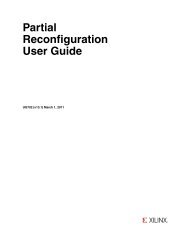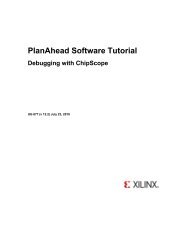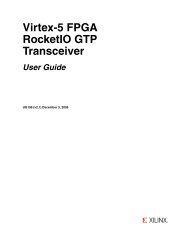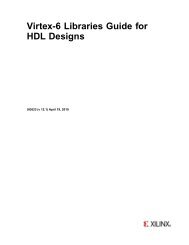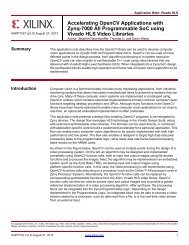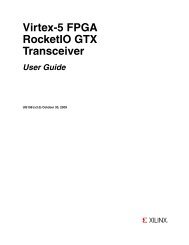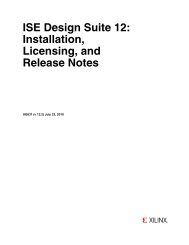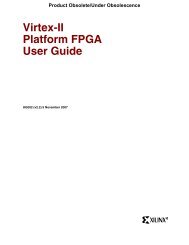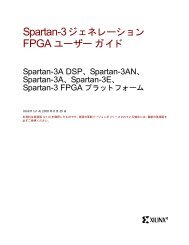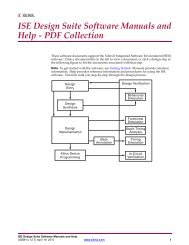- Page 1 and 2: 7 Series FPGAsIntegrated Block forP
- Page 3: Chapter 5: Constraining the CoreReq
- Page 6 and 7: SECTION I: SUMMARYIP FactsOverviewP
- Page 8 and 9: Features (Continued)• Supports En
- Page 10 and 11: Applications• Flow-control manage
- Page 12 and 13: Standards ComplianceThe core uses p
- Page 14 and 15: Available Integrated Blocks for PCI
- Page 16 and 17: Core InterfacesTable 2-6:LaneNumber
- Page 18 and 19: Transaction InterfaceTransaction In
- Page 20 and 21: Transaction InterfaceTable 2-9: Tra
- Page 22 and 23: Transaction InterfaceTable 2-10: Re
- Page 24 and 25: Transaction InterfaceTable 2-10: Re
- Page 26 and 27: Transaction InterfaceTable 2-11:Phy
- Page 28 and 29: Transaction InterfaceTable 2-11:Phy
- Page 30 and 31: Transaction InterfaceTable 2-14:Con
- Page 32 and 33: Transaction InterfaceTable 2-14:Con
- Page 34 and 35: Transaction InterfaceTable 2-16:Rol
- Page 36 and 37: Transaction InterfaceTable 2-17:Con
- Page 38 and 39: Transaction InterfaceTable 2-18: Us
- Page 40 and 41: Transaction InterfaceTable 2-19:Err
- Page 42 and 43: Transaction InterfaceTable 2-20:Dyn
- Page 44 and 45: PCI Configuration SpaceThe core imp
- Page 46 and 47: PCI Configuration SpaceTable 2-22:C
- Page 48 and 49: PCI Configuration SpaceTable 2-23:T
- Page 52 and 53: General Design Guidelinestransmitte
- Page 54 and 55: General Design GuidelinesX-Ref Targ
- Page 56 and 57: General Design GuidelinesX-Ref Targ
- Page 58 and 59: General Design GuidelinesX-Ref Targ
- Page 60 and 61: General Design Guideliness_axis_tx_
- Page 62 and 63: General Design GuidelinesX-Ref Targ
- Page 64 and 65: General Design GuidelinesX-Ref Targ
- Page 66 and 67: General Design Guidelines• Receiv
- Page 68 and 69: General Design GuidelinesX-Ref Targ
- Page 70 and 71: General Design GuidelinesDesigning
- Page 72 and 73: General Design Guidelinesis asserti
- Page 74 and 75: General Design GuidelinesX-Ref Targ
- Page 76 and 77: General Design GuidelinesX-Ref Targ
- Page 78 and 79: General Design GuidelinesX-Ref Targ
- Page 80 and 81: General Design GuidelinesX-Ref Targ
- Page 82 and 83: General Design GuidelinesTable 3-4:
- Page 84 and 85: General Design GuidelinesX-Ref Targ
- Page 86 and 87: General Design GuidelinesX-Ref Targ
- Page 88 and 89: General Design GuidelinesPacket Re-
- Page 90 and 91: General Design GuidelinesUser Appli
- Page 92 and 93: General Design GuidelinesX-Ref Targ
- Page 94 and 95: General Design GuidelinesX-Ref Targ
- Page 96 and 97: General Design GuidelinesTable 3-10
- Page 98 and 99: General Design GuidelinesFor exampl
- Page 100 and 101:
General Design Guidelines• fc_ph[
- Page 102 and 103:
General Design GuidelinesIn the cas
- Page 104 and 105:
General Design Guidelines• Before
- Page 106 and 107:
General Design GuidelinesDirected L
- Page 108 and 109:
General Design GuidelinesX-Ref Targ
- Page 110 and 111:
General Design GuidelinesDevice Con
- Page 112 and 113:
General Design Guidelinescfg_lstatu
- Page 114 and 115:
General Design GuidelinesTable 3-23
- Page 116 and 117:
General Design GuidelinesTable 3-26
- Page 118 and 119:
General Design Guidelines3. Vendor
- Page 120 and 121:
General Design GuidelinesUser logic
- Page 122 and 123:
General Design GuidelinesTable 3-34
- Page 124 and 125:
General Design GuidelinesTable 3-36
- Page 126 and 127:
General Design GuidelinesHandling M
- Page 128 and 129:
General Design GuidelinesTable 3-38
- Page 130 and 131:
General Design GuidelinesTable 3-39
- Page 132 and 133:
General Design GuidelinesX-Ref Targ
- Page 134 and 135:
General Design GuidelinesX-Ref Targ
- Page 136 and 137:
General Design GuidelinesTable 3-40
- Page 138 and 139:
General Design GuidelinesTable 3-40
- Page 140 and 141:
General Design GuidelinesActive Sta
- Page 142 and 143:
General Design GuidelinesPower-down
- Page 144 and 145:
General Design GuidelinesLegacy Int
- Page 146 and 147:
General Design GuidelinesIf Per-Vec
- Page 148 and 149:
General Design GuidelinesUsing the
- Page 150 and 151:
General Design GuidelinesTable 3-46
- Page 152 and 153:
General Design GuidelinesTable 3-46
- Page 154 and 155:
General Design GuidelinesTable 3-46
- Page 156 and 157:
General Design GuidelinesTable 3-46
- Page 158 and 159:
General Design GuidelinesTable 3-46
- Page 160 and 161:
General Design GuidelinesDesign Flo
- Page 162 and 163:
General Design GuidelinesX-Ref Targ
- Page 164 and 165:
General Design GuidelinesVC707:CONF
- Page 166 and 167:
General Design Guidelinesdesign use
- Page 168 and 169:
General Design GuidelinesThese inpu
- Page 170 and 171:
General Design Guidelinesdesign-dep
- Page 172 and 173:
General Design Guidelinescommunicat
- Page 174 and 175:
General Design GuidelinesX-Ref Targ
- Page 176 and 177:
General Design GuidelinesX-Ref Targ
- Page 178 and 179:
General Design GuidelinesAREA_GROUP
- Page 180 and 181:
General Design GuidelinesThe Persis
- Page 182 and 183:
General Design Guidelines3. When th
- Page 184 and 185:
General Design GuidelinesPower-supp
- Page 186 and 187:
ClockingWith these items implemente
- Page 188 and 189:
ClockingX-Ref Target - Figure 3-89P
- Page 190 and 191:
Protocol LayersProtocol LayersThe f
- Page 192 and 193:
FPGA ConfigurationThis section disc
- Page 194 and 195:
FPGA ConfigurationX-Ref Target - Fi
- Page 196 and 197:
FPGA Configuration100 ms ≤ T PWRV
- Page 198 and 199:
FPGA ConfigurationX-Ref Target - Fi
- Page 200 and 201:
SECTION II: VIVADO DESIGN SUITECust
- Page 202 and 203:
GUIX-Ref Target - Figure 4-1Figure
- Page 204 and 205:
GUISelecting the alternate frequenc
- Page 206 and 207:
GUI• Type: BARs can either be I/O
- Page 208 and 209:
GUIID Initial Values• Vendor ID:
- Page 210 and 211:
GUIX-Ref Target - Figure 4-5Figure
- Page 212 and 213:
GUI• Extended Tag Field: Indicate
- Page 214 and 215:
GUI• Hardware Autonomous Speed Di
- Page 216 and 217:
GUIX-Ref Target - Figure 4-7Figure
- Page 218 and 219:
GUIX-Ref Target - Figure 4-8Figure
- Page 220 and 221:
GUIX-Ref Target - Figure 4-9Figure
- Page 222 and 223:
GUIX-Ref Target - Figure 4-10Figure
- Page 224 and 225:
GUIPinout SelectionThe Pinout Selec
- Page 226 and 227:
GUIX-Ref Target - Figure 4-13Transa
- Page 228 and 229:
GUI• Force No Scrambling: Used fo
- Page 230 and 231:
Output Generation/< component_name_
- Page 232 and 233:
Device, Package, and Speed Grade Se
- Page 234 and 235:
Core Timing ConstraintsPhysical con
- Page 236 and 237:
Supported Core PinoutsTable 5-2:Pac
- Page 238 and 239:
Chapter 6Getting Started Example De
- Page 240 and 241:
Directory and File ContentsTable 6-
- Page 242 and 243:
Example DesignTable 6-5:sample_test
- Page 244 and 245:
Example DesignX-Ref Target - Figure
- Page 246 and 247:
Generating the Core1. Start the Viv
- Page 248 and 249:
Generating the CoreX-Ref Target - F
- Page 250 and 251:
Generating the CoreX-Ref Target - F
- Page 252 and 253:
SimulationX-Ref Target - Figure 6-1
- Page 254 and 255:
Chapter 7Example Design and Model T
- Page 256 and 257:
Programmed Input/Output: Endpoint E
- Page 258 and 259:
Programmed Input/Output: Endpoint E
- Page 260 and 261:
Programmed Input/Output: Endpoint E
- Page 262 and 263:
Programmed Input/Output: Endpoint E
- Page 264 and 265:
Programmed Input/Output: Endpoint E
- Page 266 and 267:
Programmed Input/Output: Endpoint E
- Page 268 and 269:
Programmed Input/Output: Endpoint E
- Page 270 and 271:
Root Port Model Test Bench for Endp
- Page 272 and 273:
Root Port Model Test Bench for Endp
- Page 274 and 275:
Root Port Model Test Bench for Endp
- Page 276 and 277:
Root Port Model Test Bench for Endp
- Page 278 and 279:
Root Port Model Test Bench for Endp
- Page 280 and 281:
Root Port Model Test Bench for Endp
- Page 282 and 283:
Root Port Model Test Bench for Endp
- Page 284 and 285:
Root Port Model Test Bench for Endp
- Page 286 and 287:
Configurator Example Design• Conf
- Page 288 and 289:
Configurator Example DesignThe Conf
- Page 290 and 291:
Configurator Example Designconfigur
- Page 292 and 293:
Endpoint Model Test Bench for Root
- Page 294 and 295:
SECTION III: ISE DESIGN SUITECustom
- Page 296 and 297:
GUIX-Ref Target - Figure 9-1Figure
- Page 298 and 299:
GUISelecting the alternate frequenc
- Page 300 and 301:
GUI• Checkbox: Click the checkbox
- Page 302 and 303:
GUIX-Ref Target - Figure 9-3Figure
- Page 304 and 305:
GUIX-Ref Target - Figure 9-4Figure
- Page 306 and 307:
GUI• Extended Tag Field: Indicate
- Page 308 and 309:
GUI• De-emphasis: Sets the level
- Page 310 and 311:
GUIPower Management RegistersThe Po
- Page 312 and 313:
GUIX-Ref Target - Figure 9-8Figure
- Page 314 and 315:
GUIX-Ref Target - Figure 9-9Figure
- Page 316 and 317:
GUIX-Ref Target - Figure 9-10Figure
- Page 318 and 319:
GUIX-Ref Target - Figure 9-12Transa
- Page 320 and 321:
Output Generation• Disable TX ASP
- Page 322 and 323:
Device, Package, and Speed Grade Se
- Page 324 and 325:
Core Timing Constraintsphysical con
- Page 326 and 327:
Supported Core PinoutsTable 10-2:Pa
- Page 328 and 329:
Supported Core PinoutsTable 10-2:Su
- Page 330 and 331:
Directory and File Contentssimulati
- Page 332 and 333:
Directory and File Contentsimplemen
- Page 334 and 335:
Directory and File ContentsTable 11
- Page 336 and 337:
Example DesignX-Ref Target - Figure
- Page 338 and 339:
Generating the CoreFor help startin
- Page 340 and 341:
Generating the Core6. In the Compon
- Page 342 and 343:
Simulation• routed.v[hd]Verilog o
- Page 344 and 345:
Chapter 12Example Design and Model
- Page 346 and 347:
Programmed Input/Output: Endpoint E
- Page 348 and 349:
Programmed Input/Output: Endpoint E
- Page 350 and 351:
Programmed Input/Output: Endpoint E
- Page 352 and 353:
Programmed Input/Output: Endpoint E
- Page 354 and 355:
Programmed Input/Output: Endpoint E
- Page 356 and 357:
Programmed Input/Output: Endpoint E
- Page 358 and 359:
Programmed Input/Output: Endpoint E
- Page 360 and 361:
Root Port Model Test Bench for Endp
- Page 362 and 363:
Root Port Model Test Bench for Endp
- Page 364 and 365:
Root Port Model Test Bench for Endp
- Page 366 and 367:
Root Port Model Test Bench for Endp
- Page 368 and 369:
Root Port Model Test Bench for Endp
- Page 370 and 371:
Root Port Model Test Bench for Endp
- Page 372 and 373:
Root Port Model Test Bench for Endp
- Page 374 and 375:
Root Port Model Test Bench for Endp
- Page 376 and 377:
Configurator Example Design• Conf
- Page 378 and 379:
Configurator Example DesignThe Conf
- Page 380 and 381:
Configurator Example Designconfigur
- Page 382 and 383:
Endpoint Model Test Bench for Root
- Page 384 and 385:
SECTION IV: APPENDICESMigratingDebu
- Page 386 and 387:
Migration ConsiderationsTable A-1:C
- Page 388 and 389:
TRN to AXI Migration Considerations
- Page 390 and 391:
TRN to AXI Migration Considerations
- Page 392 and 393:
TRN to AXI Migration Considerations
- Page 394 and 395:
TRN to AXI Migration Considerations
- Page 396 and 397:
TRN to AXI Migration Considerations
- Page 398 and 399:
Contacting Xilinx Technical Support
- Page 400 and 401:
Debug Tools• lspci -x -d []:[]Thi
- Page 402 and 403:
Hardware DebugX-Ref Target - Figure
- Page 404 and 405:
Hardware DebugFPGA Configuration Ti
- Page 406 and 407:
Hardware Debug• A component must
- Page 408 and 409:
Hardware Debug• Memory or I/O req
- Page 410 and 411:
Hardware Debugthat error detection
- Page 412 and 413:
Hardware Debug• Replay NUM Rollov
- Page 414 and 415:
Simulation DebugX-Ref Target - Figu
- Page 416 and 417:
Simulation Debug# [ 149143316] : TS
- Page 418 and 419:
Appendix CManaging Receive-Buffer S
- Page 420 and 421:
Methods of Managing Completion Spac
- Page 422 and 423:
Methods of Managing Completion Spac
- Page 424 and 425:
Methods of Managing Completion Spac
- Page 426 and 427:
Transaction Layer InterfaceTable D-
- Page 428 and 429:
Transaction Layer InterfaceTable D-
- Page 430 and 431:
Block RAM InterfaceTable D-2: Trans
- Page 432 and 433:
GTX Transceiver InterfaceTable D-4:
- Page 434 and 435:
GTX Transceiver InterfaceTable D-4:
- Page 436 and 437:
GTX Transceiver InterfaceTable D-4:
- Page 438 and 439:
Configuration Management InterfaceT
- Page 440 and 441:
Configuration Management InterfaceT
- Page 442 and 443:
Configuration Management InterfaceT
- Page 444 and 445:
Configuration Management InterfaceT
- Page 446 and 447:
Configuration Management InterfaceT
- Page 448 and 449:
Configuration Management InterfaceT
- Page 450 and 451:
Configuration Management InterfaceT
- Page 452 and 453:
Configuration Management InterfaceT
- Page 454 and 455:
Configuration Management InterfaceT
- Page 456 and 457:
Configuration Management InterfaceT
- Page 458 and 459:
Configuration Management InterfaceT
- Page 460 and 461:
Configuration Management InterfaceT
- Page 462 and 463:
Configuration Management InterfaceT
- Page 464 and 465:
Configuration Management InterfaceT
- Page 466 and 467:
Configuration Management InterfaceT
- Page 468 and 469:
Configuration Management InterfaceT
- Page 470 and 471:
TL2 Interface PortsTable D-16: Debu
- Page 472 and 473:
Appendix EAdditional ResourcesXilin
- Page 474:
Revision HistoryRevision HistoryThe



